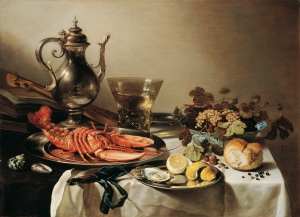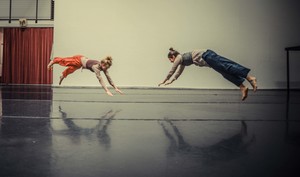In his still lifes, Dutch painter Pieter Claesz (1596/97-1660) would paint the corner of an everyday table, dressed hastily with heavy white linens, its content displayed lavishly. Objects that do not necessarily relate -a musical instrument, seashells, books, a cooked lobster on a silver plate- appeared side by side in a matter-of-fact manner. The angle of the picture gave the impression that the scene was noticed from the corner of the eye, as if captured furtively while walking through a room. Most often, Claesz placed an object partly hanging over the edge of the table, in a precarious balance. Combined with the realism of the painting, and the play between light and shadow, this conveyed the sense that something was about to happen, thus inciting an animate quality to the atmosphere of the work. In Still Life with Silverware and Lobster (1641), the reflection of the painter on the carafe seems about to shudder, and the lobster’s tail to twitch as if still grasping onto the promise of life.
The capacity to straddle between the animate and the inanimate is equally present in Bay Area choreographers Lauren Simpson and Jenny Stulberg’s Still Life Dances. Although their series is inspired by 19th and 20th century paintings found in the permanent collection of the De Young Museum in San Francisco, it displays a similar attention to details and composition as Claesz’ work. With the Still Life Dances, Simpson and Stulberg reinvestigate the small, the minute, the quirky and play with duration and modes of seeing to create a style of their own.
In both Still Life for Two No. 1 (SL1), presented during RAWdance CONCEPT series last December and Still Life for Two No. 2 (SL2) featured during ODC Pilot 65 last April, the two choreographers perform a duet that explores intricate partnering and peculiar movements. In both pieces, they fluctuate in and out of synchronicity and glean small gestures such as the hiccup of a chin or the jerking motion of a wrist. Fingers drum the floor, heels swivel, while the rest of the body stays still. Some of the movements appear involuntary and recall the reflex of a limb jerking during sleep.
Despite similarities in composition and mood between the dances and the paintings that inspired them, Simpson and Stulberg’s dances function on their own, and it is not necessary for the viewer to be familiar with the still lifes that were at the impetus of the creative process. Based on Raphaelle Peale’s Blackberries (1813), SL1 is slightly more abstract than SL2, which is inspired by William Harnett’s After the Hunt (1885) and features recognizable gestures, such as fingers mimicking a gun, and a role play between two shooters. Still Life No. 3 (SL3) based on David Ligare’s Still Life with Grape Juice and Sandwiches (1994), was presented earlier this month as part of JuMP 2015. Although the piece is performed by FACT/SF five dancers, it exemplifies the same choreographic research and inquiries as its two predecessors.
Simpson and Stulberg also play with and reverse traditional ways of seeing, thereby creating ambiguous compositions that push the medium of dance into the visual arts realm. In SL2, Simpson and Stulberg have rotated After the Hunt’s vertical composition: the work unfolds horizontally, with both performers on the floor the entire length of the piece. In SL3, the two choreographers have reversed front and back: the dancers spend a large portion of the piece with their backs to the audience. Their black jackets are buttoned backward, giving the odd impression of a body whose face is missing its feature. Another possible nod to visual arts, the scene also brings to mind the strangeness of surrealist painter René Magritte’s work.
At one point during SL1, the two dancers drop to the floor, roll to their side and catch their balance, their arms and legs hovering off the floor. Hanging on their flank momentarily, the performers are poised to fall forward. Such as the plate precariously positioned at the edge of the table in Claez’ still life, the moment captures the liminal space that exists between stillness and movement, between two and three dimensions.
Similarly, one scene of SL3 features the dancers lying sideways onto their right forearm in a diagonal facing upstage left. They are motionless for a long minute, enough time for viewers to get accustomed to the stillness of this tableau. Suddenly, the performers drag their right palm very quickly slightly forward. After a long pause, they repeat the movement. And on they go, alternating between a quick shift and stillness, until their right palm, which previously appeared glued to the floor, is in front of their torso. It is not a perceptible slow drag of their hand, but a ‘quick drag and freeze’ type of movement, which is so perfectly in synchronicity and imperceptible that you wonder if your eyes have betrayed you. The moment is reminiscent of trompe l’oeil, the technique that creates the optical illusion that painted objects on a flat surface exist in three dimensions.
Highlighting such details would not be feasible without an astute use of timing. Immobility and movement are weighted equally and in a sea of motionlessness, the details of the lift of a shoulder, the pull of an arm, or the drumming of a finger become heightened. There is no grands ronds de jambes, no sensational lifts or other traditional vocabulary borrowed from ballet or modern dance here, but a complex study of the body mechanics -joints bending, muscles flexing, eyebrows lifting- and a refreshing use of pedestrian movements, realized with tremendous craft and precision.
Mostly performed in silence or with a soundscape that exists separately from the movements, the performers are attuned to each other, taking their cues from a breath, a gaze or a movement. Sometimes the bodies come into contact, as in SL1, when Simpson and Stulberg find themselves torso against torso, and adjust their chin on each other’s shoulder. The adjustment takes a while, they look as if they want to find the perfect fit, and it is a delicious moment that lingers.
An art critic said of Pieter Claesz’s paintings that the objects depicted were carefully selected to “point to the ephemeral and fragile nature of life: the wilted flower, the watch, the skull, the upturned glass and the guttering candle.” Similarly, movements and rests are carefully selected in Simpson and Stulberg’s work. Together, they not only remind the viewer to pay attention to the small, the ephemeral, but also to the renewed possibilities that artists offer to rewrite the language of the body.




Really nice piece!!!
Brenda way
Pingback: Taken Into Stillness | Guest Post By Michelle LaVigne | TRIPLE DOG DARE